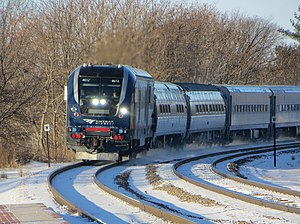 The eastbound Illinois Zephyr arriving at Princeton in 2017 | |||||
| Overview | |||||
|---|---|---|---|---|---|
| Service type | Inter-city rail | ||||
| Status | Partially operating | ||||
| Locale | Illinois | ||||
| Predecessor | American Royal Zephyr Kansas City Zephyr | ||||
| First service |
| ||||
| Current operator(s) | Amtrak | ||||
| Annual ridership | 114,521 (FY23) | ||||
| Route | |||||
| Termini | Chicago, Illinois Quincy, Illinois | ||||
| Stops | 8 | ||||
| Distance travelled | 258 miles (415 km) | ||||
| Average journey time | 4 hours, 21 minutes[2] | ||||
| Service frequency | Two daily round trips | ||||
| Train number(s) | 380–383 | ||||
| On-board services | |||||
| Class(es) | Reserved Coach and Business Class | ||||
| Seating arrangements | Airline-style coach seating | ||||
| Catering facilities | On-board café | ||||
| Technical | |||||
| Track gauge | 4 ft 8+1⁄2 in (1,435 mm) standard gauge | ||||
| Track owner(s) | BNSF | ||||
| |||||
The Illinois Zephyr and Carl Sandburg are a pair of passenger trains operated by Amtrak on a 258-mile (415 km) route between Chicago and Quincy, Illinois. As Illinois Service trains, they are partially funded by the Illinois Department of Transportation. Between Chicago and Galesburg, Illinois, the trains share their route with the California Zephyr and Southwest Chief; the remainder of the route (Galesburg–Quincy) is served exclusively by the Illinois Zephyr/Carl Sandburg.
The Illinois Zephyr is the longest continuously operated state-sponsored train, having started in November 1971.[3]: 241 The Carl Sandburg was added as the route's second daily round trip in 2006.
During fiscal year 2023, the Illinois Zephyr and Carl Sandburg carried a combined 114,521 passengers, a 14.7% decrease over fiscal year 2022.[4] The two trains had a total revenue of $10.5 million in fiscal year 2021, a 9.5% decrease over fiscal year 2014.[5]
Cite error: There are <ref group=lower-alpha> tags or {{efn}} templates on this page, but the references will not show without a {{reflist|group=lower-alpha}} template or {{notelist}} template (see the help page).
- ^ "Amtrak Fiscal Year 2023 Ridership" (PDF). Amtrak. November 27, 2023. Retrieved November 30, 2023.
- ^ "Amtrak Timetable Results". www.amtrak.com. Retrieved December 20, 2021.
- ^ Cite error: The named reference
sanderswas invoked but never defined (see the help page). - ^ "Amtrak FY23 Ridership" (PDF).
- ^ "Amtrak FY23 Ridership" (PDF). \. Retrieved January 14, 2024.
